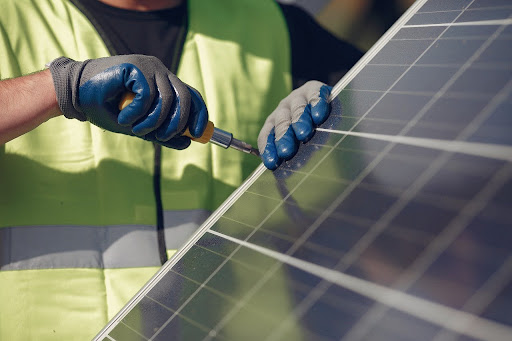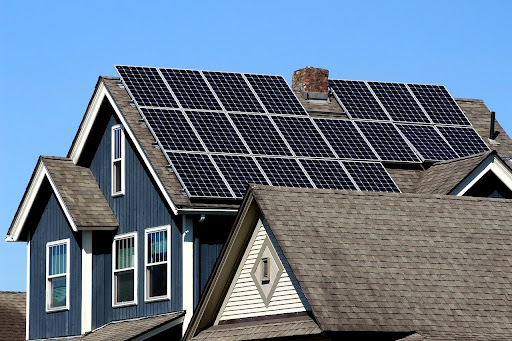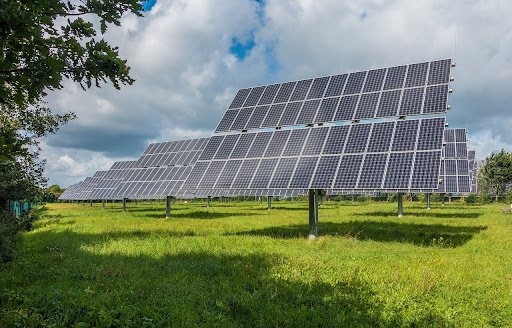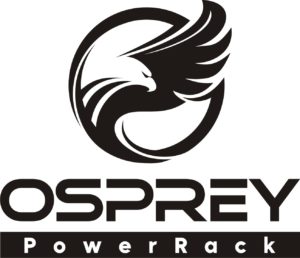Pole Ground Mount Solar Panel Racking: Pros & Cons, Alternatives
Key Takeaways
- Pole ground mounts elevate solar panels, allowing for optimal sun exposure and improved energy efficiency.
- These systems often include solar tracking technology, which can increase energy production by 25% or more.
- Pole mounts require less ground space compared to traditional ground mounts, making them ideal for limited-space installations.
- Higher initial costs and maintenance requirements are key disadvantages of pole mounts.
- Nuance Energy’s Osprey PowerRACK® is an innovative alternative that allows for quick installation using simple handheld tools.
| Nuance Energy is your superior solution for Ground Mount solar. Our patented foundation technology Osprey PowerRACK® allows for rapid installation using only handheld tools, significantly reducing both time and costs compared to traditional racking systems.
This cutting-edge technology works for residential and commercial installations, and Nuance Energy empowers solar installers to take back control of their installation schedules, control project COGS, gain market share, increase the speed of installation, and reduce the cost of labor. In contrast, a traditional ground mount is much more unpredictable, slower, and costly. Find out how Nuance Energy can accelerate your solar projects with the Osprey PowerRACK® line, and boost your profitability. Contact us today to discuss our innovative ground-mount solutions. |
An Introduction to Pole Ground Mount Racking
Pole mounts provide flexibility in positioning and can be installed on various terrains. This system uses a single pole to support a rack of solar panels, which can be adjusted to capture maximum sunlight throughout the day.
Besides that, pole mounts often come equipped with solar tracking systems. These systems automatically adjust the angle of the panels, optimizing energy absorption as the sun moves across the sky. This dynamic capability significantly boosts the energy output, making pole mounts an attractive option for those looking to maximize solar energy production.
Basic Structure
The structure of pole ground mount systems is relatively simple. A single, sturdy pole is driven deep into the ground, serving as the main support for the solar panel array. The panels are then mounted on a rack at the top of the pole, allowing for height adjustment and rotation.
One of the most critical aspects of this setup is the tracking system. Typically, this involves a combination of sensors and motors that adjust the panel’s tilt and orientation based on the sun’s position, increasing the efficiency of solar energy capture.
Common Uses
Pole ground mounts are widely used in various applications, from small residential setups to large commercial solar farms. Their ability to elevate panels above ground level is particularly beneficial in areas with limited space or uneven terrain.
For instance, in regions with frequent snowfall, pole mounts can be adjusted to prevent snow accumulation on the panels, ensuring continuous energy production even in winter months.
Additionally, these systems are particularly suitable for agricultural applications, where ground space is often reserved for crops. By elevating the panels, pole mounts minimize land use while still providing ample energy for farm operations.
Advantages of Pole Mounts
Sun Tracking Benefits
One of the standout features of pole mount systems is their ability to track the sun’s movement. This capability allows the panels to maintain an optimal angle relative to the sun, maximizing energy absorption throughout the day. As a result, pole mounts can increase energy production by up to 25% compared to fixed-tilt systems.
By continuously adjusting to the sun’s position, these systems ensure consistent energy output, even during shorter winter days or cloudy weather.
Space Efficiency
Pole mounts are designed to minimize ground space usage. Their vertical design allows for better land utilization, particularly in urban or suburban settings where the cost of land is high.
Flexibility
Pole ground mount solar panels are highly flexible, allowing installation on various terrains, including uneven, sloped, or rocky ground. Unlike rooftop systems, they aren’t limited by roof orientation and can be placed to capture maximum sunlight. This adaptability ensures efficient energy production, even in tight or challenging spaces.
Disadvantages of Pole Mounts
Higher Costs
Pole mount systems often come with a higher initial cost compared to other solar mounting options. The complexity of the tracking system and the need for durable materials to support the elevated panels contribute to these increased expenses. Additionally, installation requires specialized labor, further driving up costs.
Maintenance Needs
Because of their sophisticated tracking systems, pole mounts require regular maintenance to ensure optimal performance. This maintenance includes checking and adjusting the tracking mechanisms, cleaning the panels, and inspecting the structural integrity of the pole and mounting hardware.

Regular maintenance keeps pole mount systems operating at peak performance.
Power Requirements
Pole mount systems with tracking capabilities require a small amount of electricity to operate the motors and sensors that adjust the panels. This additional power consumption can reduce the overall energy savings achieved by the system.
Alternative Solar Racking Options
Traditional Ground-Mounted Systems
Traditional ground-mounted systems involve securing solar panels to a metal frame that is anchored to the ground. These systems are relatively simple to install and can be adapted to various terrains and site conditions. They typically require less maintenance than pole mounts, as they lack moving parts.
However, they require more ground space and can be less efficient in terms of energy production due to their fixed tilt angle. Despite this, they remain a popular choice for large-scale solar installations due to their cost-effectiveness and reliability.
Rooftop Solar Systems
Rooftop solar systems are installed directly onto the roof of a building, making them a space-efficient option for urban and suburban areas. These systems often have lower installation costs compared to ground-mounted systems, as they utilize existing structures for support.
However, their performance can be limited by the roof’s orientation, angle, and shading from nearby structures or trees. Additionally, rooftop systems may not be suitable for older or structurally compromised buildings.

Rooftop systems do not require excessive space and are ideal for urban settings.
Canopy Structures
Canopy solar structures are elevated frameworks that support solar panels above parking lots, walkways, or other open spaces. These systems provide the dual benefit of generating solar energy while offering shade and protection from the elements.
Canopy structures can be more expensive to install due to their height and complexity, but they offer significant advantages in terms of land use and multi-functionality. They are particularly popular in commercial and institutional settings where space is at a premium.
Nuance Energy’s OSPREY PowerRACK®
Nuance Energy’s Osprey PowerRACK® is a patented design that allows for quick installation using simple handheld tools. These systems are suitable for both residential and commercial solar projects and allow users more control over their installation schedules and costs, while cutting down on labor.
This system is scalable and adaptable to various terrain types and soil conditions and uses earth anchor foundation technology that eliminates the need for time-consuming prep work, such as geotechnical studies.
Choosing the Right System

Pole ground mounts are ideal for areas with limited space or those with uneven and rocky terrain.
Cost Considerations
Cost is often a primary factor in deciding which solar racking system to choose. Pole mounts tend to have higher initial costs due to their complex tracking systems and installation requirements. However, the increased energy efficiency and potential for greater energy savings can offset these costs over time.
Traditional ground-mounted systems and rooftop installations generally have lower upfront costs, making them attractive options for those on a tighter budget. However, their energy production may not match that of a pole mount system, which can impact long-term savings.
Space and Location Factors
| System Type | Space Requirements | Ideal Locations |
| Pole Mounts | Minimal ground space | Areas with limited land, uneven terrain |
| Traditional Ground-Mounted | Requires more ground area | Open fields, large plots |
| Rooftop Systems | No additional ground space needed | Urban and suburban settings |
| Canopy Structures | Utilize existing spaces like parking lots | Commercial areas, institutions |
| Nuance Energy’s Osprey PowerRACK® | Minimal ground space | Adaptable to various terrains and soil conditions |
Space and location play a significant role in determining the most suitable solar system. Pole mounts, with their elevated design, require minimal ground space and are ideal for areas with limited land or uneven terrain. They can be installed in locations that might not be suitable for other systems.
In contrast, traditional ground-mounted systems need more ground area and are best suited for open fields or large plots of land. Rooftop systems are perfect for urban or suburban settings where ground space is limited, while canopy structures are excellent for commercial areas where dual-purpose installations are beneficial.
Ultimately, the choice will depend on the specific characteristics of your site and how you plan to use the available space.
Long-Term Energy Needs
Your long-term energy needs should also influence your choice of solar racking system. Pole mounts, with their tracking capabilities, provide a higher energy output.
If your energy needs are moderate, a traditional ground-mounted system might suffice. These systems offer reliable energy production without the added complexity and cost of a tracking system.
Consider your future energy consumption patterns, potential changes in energy costs, and any plans to expand your energy system when making your decision.
Why Choose Nuance Energy’s Osprey PowerRACK® System?
Nuance Energy’s Osprey PowerRACK® serves as a quicker and more affordable alternative to traditional racking systems, with its efficient installation process and minimal labor requirements. Here’s why you should consider it for your solar project:
- No Heavy Equipment Required: Our Osprey PowerRACK® system eliminates the need for heavy equipment. Instead of relying on expensive and bulky machinery, the system is installed using handheld tools. The reduction in labor complexity translates to more control over project timelines and costs.
- Earth Anchor System: Our patented Earth Anchor System uses a small, hand-sized metal anchor tethered to a 72-inch cable that is driven deep into the ground. This design secures the solar array to withstand environmental stressors such as high winds and seismic activity.
- Faster Installation: By eliminating the need for concrete foundations or pile driving, contractors can bypass lengthy delays often caused by concrete curing or multiple site visits.
- Environmentally Friendly: The Osprey PowerRACK® offers a greener alternative to traditional solar mounting systems by eliminating the use of concrete, which is a significant source of CO2 emissions during production. By using the Earth Anchor System, we reduce the carbon footprint of each installation and ensure that the system is easy to remove or relocate if needed in the future.
- Scalability & Flexibility: Designed with adaptability in mind, our racking system is scalable for a variety of projects, from small residential setups to large utility-scale solar installations.
- Jurisdictional Compliance: The Osprey PowerRACK® system simplifies jurisdictional compliance with its built-in real-time testing capabilities and pre-approved engineering reports.
- Lower Cost Per Watt: By minimizing labor, material costs, and installation time, our system significantly lowers the cost per watt for ground-mount solar installations.
Ready to take the first step?
Contact us to learn more about our products and get a quote for your upcoming project.
Frequently Asked Questions (FAQ)
What is pole mount solar racking?
Pole mount solar racking is a system where solar panels are mounted on a single pole, elevated above the ground. This setup allows for flexibility in positioning and often includes solar tracking capabilities to maximize energy production.
How does solar tracking work?
Solar tracking involves the use of sensors and motors to adjust the angle and orientation of solar panels as the sun moves across the sky. This technology ensures that panels maintain an optimal position relative to the sun, maximizing energy absorption.
Are pole mounts more expensive?
Yes, pole mounts generally have higher upfront costs compared to other solar racking options. This is due to the complexity of the tracking system and the need for durable materials to support the elevated panels.
What are some alternatives to pole ground mount systems?
Alternatives to pole ground mount systems include rooftop solar systems, canopy solar structures, and ground-mounted racking systems like Nuance Energy’s innovative Osprey PowerRACK®. It offers a faster, more cost-effective solution with a simple installation process – ideal for both commercial and residential solar projects.
Save Time & Money on Your Next Solar Project
Request a QuoteRECENT POSTS
- DPW Solar vs Nuance Energy Mounted Solar Options: Cost & Benefits
- Geotechnical Report Cost & Requirements For Solar Projects
- Are Solar Panels Worth It In Nevada? Costs & Options
- OSPREY PowerRack Ground Mount System Compatibility: Single- and Dual-Axis Trackers
- Rammed Earth Foundation For Solar Arrays: Cost, Pros & Cons
- Agrivoltaics Explained: Solar & Agriculture Combined
- Large Scale Solar Systems Options: Pros & Cons
- Best Solar Options For Farms & Agriculture: Cost, Pros & Cons
- Unirac vs MT Solar Mounted Options: Cost & Benefits
- IronRidge vs Grengy Mounted Solar Options: Cost & Benefits

